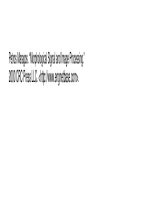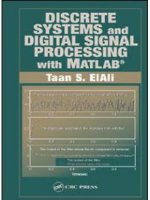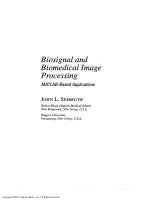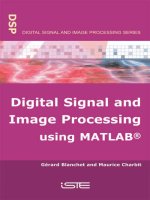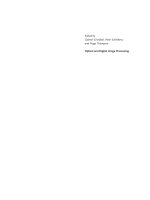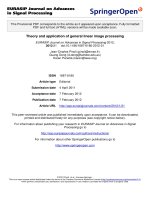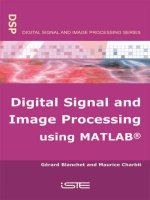biosignal and biomedical image processing matlab based applications - john l. semmlow
Bạn đang xem bản rút gọn của tài liệu. Xem và tải ngay bản đầy đủ của tài liệu tại đây (4.23 MB, 424 trang )
Biosignal and
Biomedical Image
Processing
MATLA
B-Based
Applications
JOHN
L.
SEMMLOW
Robert Wood Johnson Medical School
New Brunswick, New Jersey,
U.S.A.
Rutgers University
Piscataway, New Jersey,
U.S.A.
Copyright 2004 by Marcel Dekker, Inc. All Rights Reserved.
Although great care has been taken to provide accurate and current information, neither
the author(s) nor the publisher, nor anyone else associated with this publication, shall be
liable for any loss, damage, or liability directly or indirectly caused or alleged to be
caused by this book. The material contained herein is not intended to provide specific
advice or recommendations for any specific situation.
Trademark notice: Product or corporate names may be trademarks or registered trade-
marks and are used only for identification and explanation without intent to infringe.
Library of Congress Cataloging-in-Publication Data
A catalog record for this book is available from the Library of Congress.
ISBN: 0–8247-4803–4
This book is printed on acid-free paper.
Headquarters
Marcel Dekker, Inc., 270 Madison Avenue, New York, NY 10016, U.S.A.
tel: 212-696-9000; fax: 212-685-4540
Distribution and Customer Service
Marcel Dekker, Inc., Cimarron Road, Monticello, New York 12701, U.S.A.
tel: 800-228-1160; fax: 845-796-1772
Eastern Hemisphere Distribution
Marcel Dekker AG, Hutgasse 4, Postfach 812, CH-4001 Basel, Switzerland
tel: 41-61-260-6300; fax: 41-61-260-6333
World Wide Web
The publisher offers discounts on this book when ordered in bulk quantities. For more
information, write to Special Sales/Professional Marketing at the headquarters address
above.
Copyright 2004 by Marcel Dekker, Inc. All Rights Reserved.
Neither this book nor any part may be reproduced or transmitted in any form or by any
means, electronic or mechanical, including photocopying, microfilming, and recording,
or by any information storage and retrieval system, without permission in writing from
the publisher.
Current printing (last digit):
10987654321
PRINTED IN THE UNITED STATES OF AMERICA
Copyright 2004 by Marcel Dekker, Inc. All Rights Reserved.
Copyright 2004 by Marcel Dekker, Inc. All Rights Reserved.
Copyright 2004 by Marcel Dekker, Inc. All Rights Reserved.
To Lawrence Stark, M.D., who has shown me the many possibilities
Copyright 2004 by Marcel Dekker, Inc. All Rights Reserved.
Series Introduction
Over the past 50 years, digital signal processing has evolved as a major engi-
neering discipline. The fields of signal processing have grown from the origin
of fast Fourier transform and digital filter design to statistical spectral analysis
and array processing, image, audio, and multimedia processing, and shaped de-
velopments in high-performance VLSI signal processor design. Indeed, there
are few fields that enjoy so many applications—signal processing is everywhere
in our lives.
When one uses a cellular phone, the voice is compressed, coded, and
modulated using signal processing techniques. As a cruise missile winds along
hillsides searching for the target, the signal processor is busy processing the
images taken along the way. When we are watching a movie in HDTV, millions
of audio and video data are being sent to our homes and received with unbeliev-
able fidelity. When scientists compare DNA samples, fast pattern recognition
techniques are being used. On and on, one can see the impact of signal process-
ing in almost every engineering and scientific discipline.
Because of the immense importance of signal processing and the fast-
growing demands of business and industry, this series on signal processing
serves to report up-to-date developments and advances in the field. The topics
of interest include but are not limited to the following:
• Signal theory and analysis
• Statistical signal processing
• Speech and audio processing
Copyright 2004 by Marcel Dekker, Inc. All Rights Reserved.
• Image and video processing
• Multimedia signal processing and technology
• Signal processing for communications
• Signal processing architectures and VLSI design
We hope this series will provide the interested audience with high-quality,
state-of-the -art signal processing literature through research monographs, edited
books, and rigorously written textbooks by experts in their fields.
Copyright 2004 by Marcel Dekker, Inc. All Rights Reserved.
Preface
Signal processing can be broadly defined as the application of analog or digital
techniques to improve the utility of a data stream. In biomedical engineering
applications, improved utility usually means the data provide better diagnostic
information. Analog techniques are applied to a data stream embodied as a time-
varying electrical signal while in the digital domain the data are represented as
an array of numbers. This array could be the digital representation of a time -
varying signal, or an image. This text deals exclusively with signal processing
of digital data, although Chapter 1 briefly describes analog processes commonly
found in medical devices.
This text should be of interest to a broad spectrum of engineers, but it
is written specifically for biomedical engineers (also known as bioengineers).
Although the applications are different, the signal processing methodology used
by biomedical engineers is identical to that used by other engineers such electri-
cal and communications engineers. The major difference for biomedical engi-
neers is in the level of understanding required for appropriate use of this technol-
ogy. An electrical engineer may be required to expand or modify signal
processing tools, while for biomedical engineers, signal processing techniques
are tools to be used. For the biomedical engineer, a detailed understanding of
the underlying theory, while always of value, may not be essential. Moreover,
considering the broad range of knowledge required to be effective in this field,
encompassing both medical and engineering domains, an in-depth understanding
of all of the useful technology is not realistic. It is important is to know what
Copyright 2004 by Marcel Dekker, Inc. All Rights Reserved.
tools are available, have a good understanding of what they do (if not how they
do it), be aware of the most likely pitfalls and misapplications, and know how
to implement these tools given available software packages. The basic concept
of this text is that, just as the cardiologist can benefit from an oscilloscope-type
display of the ECG without a deep understanding of electronics, so a biomedical
engineer can benefit from advanced signal processing tools without always un-
derstanding the details of the underlying mathematics.
As a reflection of this philosophy, most of the concepts covered in this
text are presented in two sections. The first part provides a broad, general under-
standing of the approach sufficient to allow intelligent application of the con-
cepts. The second part describes how these tools can be implemented and relies
primarily on the MATLAB software package and several of its toolboxes.
This text is written for a single-semester course combining signal and
image processing. Classroom experience using notes from this text indicates
that this ambitious objective is possible for most graduate formats, although
eliminating a few topics may be desirable. For example, some of the introduc-
tory or basic material covered in Chapters 1 and 2 could be skipped or treated
lightly for students with the appropriate prerequisites. In addition, topics such
as advanced spectral methods (Chapter 5), time-frequency analysis (Chapter 6),
wavelets (Chapter 7), advanced filters (Chapter 8), and multivariate analysis
(Chapter 9) are pedagogically independent and can be covered as desired with-
out affecting the other material.
Although much of the material covered here will be new to most students,
the book is not intended as an “introductory” text since the goal is to provide a
working knowledge of the topics presented without the need for additional
course work. The challenge of covering a broad range of topics at a useful,
working depth is motivated by current trends in biomedical engineering educa-
tion, particularly at the graduate level where a comprehensive education must
be attained with a minimum number of courses. This has led to the development
of “core” courses to be taken by all students. This text was written for just such
a core course in the Graduate Program of Biomedical Engineering at Rutgers
University. It is also quite suitable for an upper-level undergraduate course and
would be of value for students in other disciplines who would benefit from a
working knowledge of signal and image processing.
It would not be possible to cover such a broad spectrum of material to a
depth that enables productive application without heavy reliance on MATLAB-
based examples and problems. In this regard, the text assumes the student
has some knowledge of MATLAB programming and has available the basic
MATLAB software package including the Signal Processing and Image Process-
ing Toolboxes. (MATLAB also produces a Wavelet Toolbox, but the section on
wavelets is written so as not to require this toolbox, primarily to keep the num-
ber of required toolboxes to a minimum. ) The problems are an essential part of
Copyright 2004 by Marcel Dekker, Inc. All Rights Reserved.
this text and often provide a discovery-like experience regarding the associated
topic. A few peripheral topics are introduced only though the problems. The
code used for all examples is provided in the CD accompanying this text. Since
many of the problems are extensions or modifications of examples given in the
chapter, some of the coding time can be reduced by starting with the code of a
related example. The CD also includes support routines and data files used in
the examples and problems. Finally, the CD contains the code used to generate
many of the figures. For instructors, there is a CD available that contains the
problem solutions and Powerpoint presentations from each of the chapters.
These presentations include figures, equations, and text slides related to chapter.
Presentations can be modified by the instructor as desired.
In addition to heavy reliance on MATLAB problems and examples, this
text makes extensive use of simulated data. Except for the section on image
processing, examples involving biological signals are rarely used. In my view,
examples using biological signals provide motivation, but they are not generally
very instructive. Given the wide range of material to be presented at a working
depth, emphasis is placed on learning the tools of signal processing; motivation
is left to the reader (or the instructor).
Organization of the text is straightforward. Chapters 1 through 4 are fairly
basic. Chapter 1 covers topics related to analog signal processing and data acqui-
sition while Chapter 2 includes topics that are basic to all aspects of signal and
image processing. Chapters 3 and 4 cover classical spectral analysis and basic
digital filtering, topics fundamental to any signal processing course. Advanced
spectral methods, covered in Chapter 5, are important due to their widespread
use in biomedical engineering. Chapter 6 and the first part of Chapter 7 cover
topics related to spectral analysis when the signal’s spectrum is varying in time,
a condition often found in biological signals. Chapter 7 also covers both contin-
uous and discrete wavelets, another popular technique used in the analysis of
biomedical signals. Chapters 8 and 9 feature advanced topics. In Chapter 8,
optimal and adaptive filters are covered, the latter’s inclusion is also motivated
by the time-varying nature of many biological signals. Chapter 9 introduces
multivariate techniques, specifically principal component analysis and indepen-
dent component analysis, two analysis approaches that are experiencing rapid
growth with regard to biomedical applications. The last four chapters cover
image processing, with the first of these, Chapter 10, covering the conventions
used by MATLAB’s Imaging Processing Toolbox. Image processing is a vast
area and the material covered here is limited primarily to areas associated with
medical imaging: image acquisition (Chapter 13); image filtering, enhancement,
and trans forma tion (Chapt er 11); and segmen tatio n, and registrati on (Chapter 12).
Many of the chapters cover topics that can be adequately covered only in
a book dedicated solely to these topics. In this sense, every chapter represents
a serious compromise with respect to comprehensive coverage of the associated
Copyright 2004 by Marcel Dekker, Inc. All Rights Reserved.
topics. My only excuse for any omissions is that classroom experience with this
approach seems to work: students end up with a working knowledge of a vast
array of signal and image processing tools. A few of the classic or major books
on these topics are cited in an Annotated bibliography at the end of the book.
No effort has been made to construct an extensive bibliography or reference list
since more current lists would be readily available on the Web.
TEXTBOOK PROTOCOLS
In most early examples that feature MATLAB code, the code is presented in
full, while in the later examples some of the routine code (such as for plotting,
display, and labeling operation) is omitted. Nevertheless, I recommend that stu-
dents carefully label (and scale when appropriate) all graphs done in the prob-
lems. Some effort has been made to use consistent notation as described in
Table 1. In general, lower-case letters n and k are used as data subscripts, and
capital letters, N and K are used to indicate the length (or maximum subscript
value) of a data set. In two-dimensional data sets, lower-case letters m and n
are used to indicate the row and column subscripts of an array, while capital
letters M and N are used to indicate vertical and horizontal dimensions, respec-
tively. The letter m is also used as the index of a variable produced by a transfor-
mation, or as an index indicating a particular member of a family of related
functions.* While it is common to use brackets to enclose subscripts of discrete
variables (i.e., x[n]), ordinary parentheses are used here. Brackets are reserved
to indicate vectors (i.e., [x
1
,x
2
,x
3
, ]) following MATLAB convention.
Other notation follows standard conventions.
Italics (“) are used to introduce important new terms that should be incor-
porated into the reader’s vocabulary. If the meaning of these terms is not obvi-
ous from their use, they are explained where they are introduced. All MATLAB
commands, routines, variables, and code are shown in the
Courier typeface
.
Single quotes are used to highlight MATLAB filenames or string variables.
Textbook protocols are summarized in Table 1.
I wish to thank Susanne Oldham who managed to edit this book, and
provided strong, continuing encouragement and support. I would also like to
acknowledge the patience and support of Peggy Christ and Lynn Hutchings.
Professor Shankar Muthu Krishnan of Singapore provided a very thoughtful
critique of the manuscript which led to significant improvements. Finally, I
thank my students who provided suggestions and whose enthusiasm for the
material provided much needed motivation.
*For example, m would be used to indicate the harmonic number of a family of harmonically related
sine functions; i.e., f
m
(t) = sin (2 π m t).
Copyright 2004 by Marcel Dekker, Inc. All Rights Reserved.
T
ABLE
1 Textbook Conventions
Symbol Description/General usage
x(t), y(t) General functions of time, usually a waveform or signal
k, n Data indices, particularly for digitized time data
K, N Maximum index or size of a data set
x(n), y(n) Waveform variable, usually digitized time variables (i.e., a dis-
creet variable)
m Index of variable produced by transformation, or the index of
specifying the member number of a family of functions (i.e.,
f
m
(t))
X(f), Y(f) Frequency representation (complex) of a time function
X(m), Y(m) Frequency representation (complex) of a discreet variable
h(t) Impulse response of a linear system
h(n) Discrete impulse response of a linear system
b(n) Digital filter coefficients representing the numerator of the dis-
creet Transfer Function; hence the same as the impulse re-
sponse
a(n) Digital filter coefficients representing the denominator of the dis-
creet Transfer Function
Courier font
MATLAB command, variable, routine, or program.
Courier font
MATLAB filename or string variable
John L. Semmlow
Copyright 2004 by Marcel Dekker, Inc. All Rights Reserved.
Contents
Preface
1 Introduction
Typical Measurement Systems
Transducers
Further Study: The Transducer
Analog Signal Processing
Sources of Variability: Noise
Electronic Noise
Signal-to-Noise Ratio
Analog Filters: Filter Basics
Filter Types
Filter Bandwidth
Filter Order
Filter Initial Sharpness
Analog-to-Digital Conversion: Basic Concepts
Analog-to-Digital Conversion Techniques
Quantization Error
Further Study: Successive Approximation
Time Sampling: Basics
Further Study: Buffering and Real-Time Data Processing
Copyright 2004 by Marcel Dekker, Inc. All Rights Reserved.
Data Banks
Problems
2 Basic Concepts
Noise
Ensemble Averaging
MATLAB Implementation
Data Functions and Transforms
Convolution, Correlation, and Covariance
Convolution and the Impulse Response
Covariance and Correlation
MATLAB Implementation
Sampling Theory and Finite Data Considerations
Edge Effects
Problems
3 Spectral Analysis: Classical Methods
Introduction
The Fourier Transform: Fourier Series Analysis
Periodic Functions
Symmetry
Discrete Time Fourier Analysis
Aperiodic Functions
Frequency Resolution
Truncated Fourier Analysis: Data Windowing
Power Spectrum
MATLAB Implementation
Direct FFT and Windowing
The Welch Method for Power Spectral Density Determination
Widow Functions
Problems
4 Digital Filters
The Z-Transform
Digital Transfer Function
MATLAB Implementation
Finite Impulse Response (FIR) Filters
FIR Filter Design
Copyright 2004 by Marcel Dekker, Inc. All Rights Reserved.
Derivative Operation: The Two-Point Central Difference
Algorithm
MATLAB Implementation
Infinite Impulse Response (IIR) Filters
Filter Design and Application Using the MATLAB Signal
Processing Toolbox
FIR Filters
Two-Stage FIR Filter Design
Three-Stage Filter Design
IIR Filters
Two-Stage IIR Filter Design
Three-Stage IIR Filter Design: Analog Style Filters
Problems
5 Spectral Analysis: Modern Techniques
Parametric Model-Based Methods
MATLAB Implementation
Non-Parametric Eigenanalysis Frequency Estimation
MATLAB Implementation
Problems
6 Time–Frequency Methods
Basic Approaches
Short-Term Fourier Transform: The Spectrogram
Wigner-Ville Distribution: A Special Case of Cohen’s Class
Choi-Williams and Other Distributions
Analytic Signal
MATLAB Implementation
The Short-Term Fourier Transform
Wigner-Ville Distribution
Choi-Williams and Other Distributions
Problems
7 The Wavelet Transform
Introduction
The Continuous Wavelet Transform
Wavelet Time— Frequency Characteristics
MATLAB Implementation
Copyright 2004 by Marcel Dekker, Inc. All Rights Reserved.
The Discrete Wavelet Transform
Filter Banks
The Relationship Between Analytical Expressions and
Filter Banks
MATLAB Implementation
Denoising
Discontinuity Detection
Feature Detection: Wavelet Packets
Problems
8 Advanced Signal Processing Techniques:
Optimal and Adaptive Filters
Optimal Signal Processing: Wiener Filters
MATLAB Implementation
Adaptive Signal Processing
Adaptive Noise Cancellation
MATLAB Implementation
Phase Sensitive Detection
AM Modulation
Phase Sensitive Detectors
MATLAB Implementation
Problems
9 Multivariate Analyses: Principal Component Analysis
and Independent Component Analysis
Introduction
Principal Component Analysis
Order Selection
MATLAB Implementation
Data Rotation
Principal Component Analysis Evaluation
Independent Component Analysis
MATLAB Implementation
Problems
10 Fundamentals of Image Processing: MATLAB Image
Processing Toolbox
Image Processing Basics: MATLAB Image Formats
General Image Formats: Image Array Indexing
Copyright 2004 by Marcel Dekker, Inc. All Rights Reserved.
Data Classes: Intensity Coding Schemes
Data Formats
Data Conversions
Image Display
Image Storage and Retrieval
Basic Arithmetic Operations
Advanced Protocols: Block Processing
Sliding Neighborhood Operations
Distinct Block Operations
Problems
11 Image Processing: Filters, Transformations,
and Registration
Spectral Analysis: The Fourier Transform
MATLAB Implementation
Linear Filtering
MATLAB Implementation
Filter Design
Spatial Transformations
MATLAB Implementation
Affine Transformations
General Affine Transformations
Projective Transformations
Image Registration
Unaided Image Registration
Interactive Image Registration
Problems
12 Image Segmentation
Pixel-Based Methods
Threshold Level Adjustment
MATLAB Implementation
Continuity-Based Methods
MATLAB Implementation
Multi-Thresholding
Morphological Operations
MATLAB Implementation
Edge-Based Segmentation
MATLAB Implementation
Problems
Copyright 2004 by Marcel Dekker, Inc. All Rights Reserved.
13 Image Reconstruction
CT, PET, and SPECT
Fan Beam Geometry
MATLAB Implementation
Radon Transform
Inverse Radon Transform: Parallel Beam Geometry
Radon and Inverse Radon Transform: Fan Beam Geometry
Magnetic Resonance Imaging
Basic Principles
Data Acquisition: Pulse Sequences
Functional MRI
MATLAB Implementation
Principal Component and Independent Component Analysis
Problems
Annotated Bibliography
Copyright 2004 by Marcel Dekker, Inc. All Rights Reserved.
Annotated Bibliography
The following is a very selective list of books or articles that will be of value of in
providing greater depth and mathematical rigor to the material presented in this text.
Comments regarding the particular strengths of the reference are included.
Akansu, A. N. and Haddad, R. A., Multiresolution Signal Decomposition: Transforms,
subbands, wavelets. Academic Press, San Diego CA, 1992. A modern classic that
presents, among other things, some of the underlying theoretical aspects of wavelet
analysis.
Aldroubi A and Unser, M. (eds) Wavelets in Medicine and Biology, CRC Press, Boca
Raton, FL, 1996. Presents a variety of applications of wavelet analysis to biomedical
engineering.
Boashash, B. Time-Frequency Signal Analysis, Longman Cheshire Pty Ltd., 1992. Early
chapters provide a very useful introduction to time–frequency analysis followed by a
number of medical applications.
Boashash, B. and Black, P.J. An efficient real-time implementation of the Wigner-Ville
Distribution, IEEE Trans. Acoust. Speech Sig. Proc. ASSP-35:1611–1618, 1987.
Practical information on calculating the Wigner-Ville distribution.
Boudreaux-Bartels, G. F. and Murry, R. Time-frequency signal representations for bio-
medical signals. In: The Biomedical Engineering Handbook. J. Bronzino (ed.) CRC
Press, Boca Raton, Florida and IEEE Press, Piscataway, N.J., 1995. This article pres-
ents an exhaustive, or very nearly so, compilation of Cohen’s class of time-frequency
distributions.
Bruce, E. N. Biomedical Signal Processing and Signal Modeling, John Wiley and Sons,
Copyright 2004 by Marcel Dekker, Inc. All Rights Reserved.
New York, 2001. Rigorous treatment with more of an emphasis on linear systems
than signal processing. Introduces nonlinear concepts such as chaos.
Cichicki, A and Amari S. Adaptive Bilnd Signal and Image Processing: Learning Algo-
rithms and Applications, John Wiley and Sons, Inc. New York, 2002. Rigorous,
somewhat dense, treatment of a wide range of principal component and independent
component approaches. Includes disk.
Cohen, L. Time-frequency distributions—A review. Proc. IEEE 77:941–981, 1989.
Classic review article on the various time-frequency methods in Cohen’s class of
time–frequency distributions.
Ferrara, E. and Widrow, B. Fetal Electrocardiogram enhancement by time-sequenced
adaptive filtering. IEEE Trans. Biomed. Engr. BME-29:458–459, 1982. Early appli-
cation of adaptive noise cancellation to a biomedical engineering problem by one of
the founders of the field. See also Widrow below.
Friston, K. Statistical Parametric Mapping On-line at: /spm/
course/note02/ Through discussion of practical aspects of fMRI analysis including
pre-processing, statistical methods, and experimental design. Based around SPM anal-
ysis software capabilities.
Haykin, S. Adaptive Filter Theory (2
nd
ed.), Prentice-Hall, Inc., Englewood Cliffs, N.J.,
1991. The definitive text on adaptive filters including Weiner filters and gradient-
based algorithms.
Hyva
¨
rinen, A. Karhunen, J. and Oja, E. Independent Component Analysis, John Wiley
and Sons, Inc. New York, 2001. Fundamental, comprehensive, yet readable book on
independent component analysis. Also provides a good review of principal compo-
nent analysis.
Hubbard B.B. The World According to Wavelets (2
nd
ed.) A.K. Peters, Ltd. Natick, MA,
1998. Very readable introductory book on wavelengths including an excellent section
on the foyer transformed. Can be read by a non-signal processing friend.
Ingle, V.K. and Proakis, J. G. Digital Signal Processing with MATLAB, Brooks/Cole,
Inc. Pacific Grove, CA, 2000. Excellent treatment of classical signal processing meth-
ods including the Fourier transform and both FIR and IIR digital filters. Brief, but
informative section on adaptive filtering.
Jackson, J. E. A User’s Guide to Principal Components, John Wiley and Sons, New
York, 1991. Classic book providing everything you ever want to know about principal
component analysis. Also covers linear modeling and introduces factor analysis.
Johnson, D.D. Applied Multivariate Methods for Data Analysis, Brooks/Cole, Pacific
Grove, CA, 1988. Careful, detailed coverage of multivariate methods including prin-
cipal components analysis. Good coverage of discriminant analysis techniques.
Kak, A.C and Slaney M. Principles of Computerized Tomographic Imaging. IEEE Press,
New York, 1988. Thorough, understandable treatment of algorithms for reconstruc-
tion of tomographic images including both parallel and fan-beam geometry. Also
includes techniques used in reflection tomography as occurs in ultrasound imaging.
Marple, S.L. Digital Spectral Analysis with Applications, Prentice-Hall, Englewood
Cliffs, NJ, 1987. Classic text on modern spectral analysis methods. In-depth, rigorous
treatment of Fourier transform, parametric modeling methods (including AR and
ARMA), and eigenanalysis-based techniques.
Rao, R.M. and Bopardikar, A.S. Wavelet Transforms: Introduction to Theory and Appli-
Copyright 2004 by Marcel Dekker, Inc. All Rights Reserved.
cations, Addison-Wesley, Inc., Reading, MA, 1998. Good development of wavelet
analysis including both the continuous and discreet wavelet transforms.
Shiavi, R Introduction to Applied Statistical Signal Analysis,(2
nd
ed), Academic Press,
San Diego, CA, 1999. Emphasizes spectral analysis of signals buried in noise. Excel-
lent coverage of Fourier analysis, and autoregressive methods. Good introduction to
statistical signal processing concepts.
Sonka, M., Hlavac V., and Boyle R. Image processing, analysis, and machine vision.
Chapman and Hall Computing, London, 1993. A good description of edge-based and
other segmentation methods.
Strang, G and Nguyen, T. Wavelets and Filter Banks, Wellesley-Cambridge Press,
Wellesley, MA, 1997. Thorough coverage of wavelet filter banks including extensive
mathematical background.
Stearns, S.D. and David, R.A Signal Processing Algorithms in MATLAB, Prentice Hall,
Upper Saddle River, NJ, 1996. Good treatment of the classical Fourier transform and
digital filters. Also covers the LMS adaptive filter algorithm. Disk enclosed.
Wickerhauser, M.V. Adapted Wavelet Analysis from Theory to Software, A.K. Peters,
Ltd. and IEEE Press, Wellesley, MA, 1994. Rigorous, extensive treatment of wavelet
analysis.
Widrow, B. Adaptive noise cancelling: Principles and applications. Proc IEEE 63:1692–
1716, 1975. Classic original article on adaptive noise cancellation.
Wright S. Nuclear Magnetic Resonance and Magnetic Resonance Imaging. In: Introduc-
tion to Biomedical Engineering (Enderle, Blanchard and Bronzino, Eds.) Academic
Press, San Diego, CA, 2000. Good mathematical development of the physics of MRI
using classical concepts.
Copyright 2004 by Marcel Dekker, Inc. All Rights Reserved.
1
Introduction
TYPICAL MEASUREMENT SYSTEMS
A schematic representation of a typical biomedical measurement system is
shown in Figure 1.1. Here we use the term measurement in the most general
sense to include image acquisition or the acquisition of other forms of diagnostic
information. The physiological process of interest is converted into an electric
F
IGURE
1.1 Schematic representation of typical bioengineering measurement
system.
Copyright 2004 by Marcel Dekker, Inc. All Rights Reserved.
signal via the transducer (Figure 1.1). Some analog signal processing is usually
required, often including amplification and lowpass (or bandpass) filtering.
Since most signal processing is easier to implement using digital methods, the
analog signal is converted to digital format using an analog-to-digital converter.
Once converted, the signal is often stored, or buffered, in memory to facilitate
subsequent signal processing. Alternatively, in some real -time* applications, the
incoming data must be processed as quickly as possible with minimal buffering,
and may not need to be permanently stored. Digital signal processing algorithms
can then be applied to the digitized signal. These signal processing techniques
can take a wide variety of forms and various levels of sophistication, and they
make up the major topic area of this book. Some sort of output is necessary in
any useful system. This usually takes the form of a display, as in imaging sys-
tems, but may be some type of an effector mechanism such as in an automated
drug delivery system.
With the exception of this chapter, this book is limited to digital signal
and image processing concerns. To the extent possible, each topic is introduced
with the minimum amount of information required to use and understand the
approach, and enough information to apply the methodology in an intelligent
manner. Understanding of strengths and weaknesses of the various methods is
also covered, particularly through discovery in the problems at the end of the
chapter. Hence, the problems at the end of each chapter, most of which utilize
the MATLAB
TM
software package (Waltham, MA), constitute an integral part
of the book: a few topics are introduced only in the problems.
A fundamental assumption of this text is that an in-depth mathematical
treatment of signal processing methodology is not essential for effective and
appropriate application of these tools. Thus, this text is designed to develop
skills in the application of signal and image processing technology, but may not
provide the skills necessary to develop new techniques and algorithms. Refer-
ences are provided for those who need to move beyond application of signal
and image processing tools to the design and development of new methodology.
In subsequent chapters, each major section is followed by a section on imple-
mentation using the MATLAB software package. Fluency with the MATLAB
language is assumed and is essential for the use of this text. Where appropriate,
a topic area may also include a more in-depth treatment including some of the
underlying mathematics.
*Learning the vocabulary is an important part of mastering a discipline. In this text we highlight,
using italics, terms commonly used in signal and image processing. Sometimes the highlighted term
is described when it is introduced, but occasionally determination of its definition is left to responsi-
bility of the reader. Real-time processing and buffering are described in the section on analog-to-
digital conversion.
Copyright 2004 by Marcel Dekker, Inc. All Rights Reserved.
TRANSDUCERS
A transducer is a device that converts energy from one form to another. By this
definition, a light bulb or a motor is a transducer. In signal processing applica-
tions, the purpose of energy conversion is to transfer information, not to trans-
form energy as with a light bulb or a motor. In measurement systems, all trans-
ducers are so-called input transducers, they convert non-electrical energy into
an electronic signal. An exception to this is the electrode, a transducer that
converts electrical energy from ionic to electronic form. Usually, the output of
a biomedical transducer is a voltage (or current) whose amplitude is proportional
to the measured energy.
The energy that is converted by the input transducer may be generated by
the physiological process itself, indirectly related to the physiological process,
or produced by an external source. In the last case, the externally generated
energy interacts with, and is modified by, the physiological process, and it is
this alteration that produces the measurement. For example, when externally
produced x-rays are transmitted through the body, they are absorbed by the
intervening tissue, and a measurement of this absorption is used to construct an
image. Many diagnostically useful imaging systems are based on this external
energy approach.
In addition to passing external energy through the body, some images are
generated using the energy of radioactive emissions of radioisotopes injected
into the body. These techniques make use of the fact that selected, or tagged,
molecules will collect in specific tissue. The areas where these radioisotopes
collect can be mapped using a gamma camera, or with certain short-lived iso-
topes, better localized using positron emission tomography (PET).
Many physiological processes produce energy that can be detected di-
rectly. For example, cardiac internal pressures are usually measured using a
pressure transducer placed on the tip of catheter introduced into the appropriate
chamber of the heart. The measurement of electrical activity in the heart, mus-
cles, or brain provides other examples of the direct measurement of physiologi-
cal energy. For these measurements, the energy is already electrical and only
needs to be converted from ionic to electronic current using an electrode. These
sources are usually given the term ExG, where the ‘x’ represents the physiologi-
cal process that produces the electrical energy: ECG–electrocardiogram, EEG–
electroencephalogram; EMG–electromyogram; EOG–electrooculargram, ERG–
electroretini ogram ; and EGG–el ectro gastr ogram. An ex cepti on to this terminology
is the electrical activity generated by this skin which is termed the galvanic skin
response, GSR. Typical physiological energies and the applications that use
these energy forms are shown in Table 1.1
The biotransducer is often the most critical element in the system since it
constitutes the interface between the subject or life process and the rest of the
Copyright 2004 by Marcel Dekker, Inc. All Rights Reserved.
T
ABLE
1.1 Energy Forms and Related Direct Measurements
Energy Measurement
Mechanical
length, position, and velocity muscle movement, cardiovascular pressures,
muscle contractility
force and pressure valve and other cardiac sounds
Heat body temperature, thermography
Electrical EEG, ECG, EMG, EOG, ERG, EGG, GSR
Chemical ion concentrations
system. The transducer establishes the risk, or noninvasiveness , of the overall
system. For example, an imaging system based on differential absorption of
x-rays, such as a CT (computed tomography) scanner is considered more inva-
sive than an imagining system based on ultrasonic reflection since CT uses
ionizing radiation that may have an associated risk. (The actual risk of ionizing
radiation is still an open question and imaging systems based on x-ray absorp-
tion are considered minimally invasive.) Both ultrasound and x-ray imaging
would be considered less invasive than, for example, monitoring internal cardiac
pressures through cardiac catherization in which a small catheter is treaded into
the heart chambers. Indeed many of the outstanding problems in biomedical
measurement, such as noninvasive measurement of internal cardiac pressures,
or the noninvasive measurement of intracranial pressure, await an appropriate
(and undoubtedly clever) transducer mechanism.
Further Study: The Transducer
The transducer often establishes the major performance criterion of the system.
In a later section, we list and define a number of criteria that apply to measure-
ment systems; however, in practice, measurement resolution, and to a lesser
extent bandwidth, are generally the two most important and troublesome mea-
surement criteria. In fact, it is usually possible to trade-off between these two
criteria. Both of these criteria are usually established by the transducer. Hence,
although it is not the topic of this text, good system design usually calls for care
in the choice or design of the transducer element(s). An efficient, low-noise
transducer design can often reduce the need for extensive subsequent signal
processing and still produce a better measurement.
Input transducers use one of two different fundamental approaches: the
input energy causes the transducer element to generate a voltage or current, or
the input energy creates a change in the electrical properties (i.e., the resistance,
inductance, or capacitance) of the transducer element. Most optical transducers
Copyright 2004 by Marcel Dekker, Inc. All Rights Reserved.
